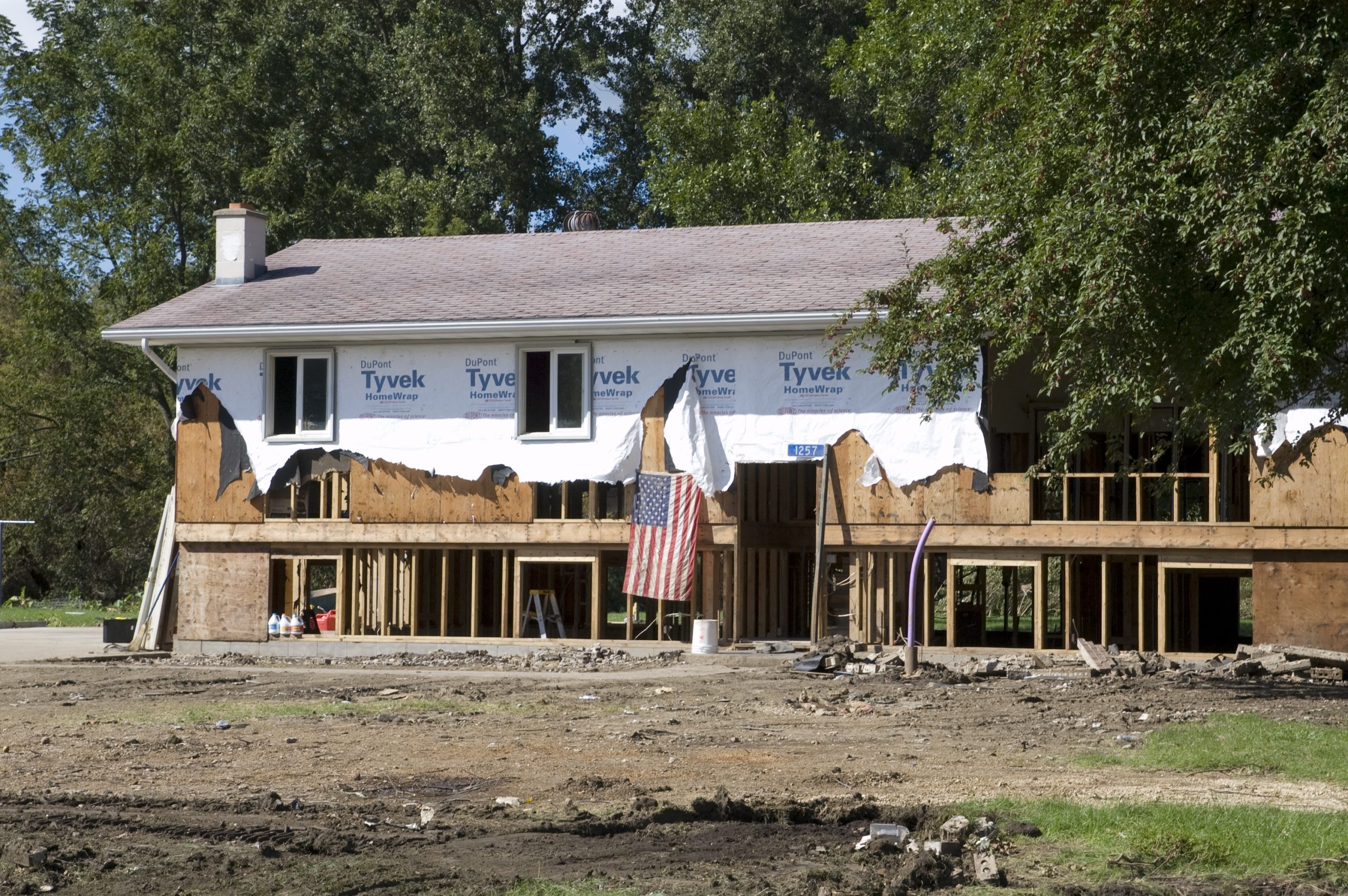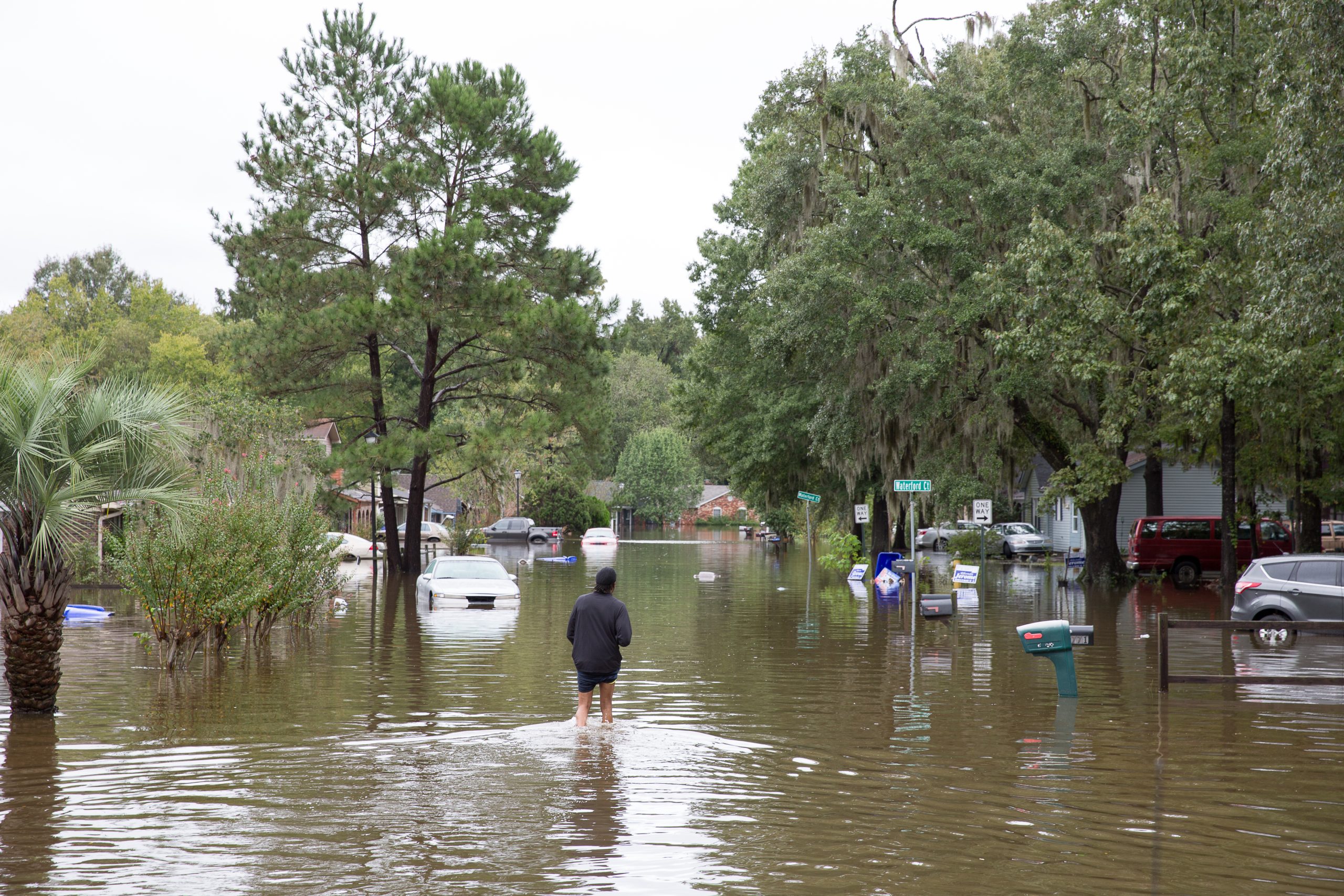Instead of Bluelining, Support Resilience, Relocation, and Realistic Development (Bluelining Part 2 of 2)
Financial policies and practices needed nationwide to reduce household climate vulnerability
By Jessica Garcia, senior policy analyst for climate finance
Physical risks from climate change are growing, and the pace is accelerating. In 2023, the United States set an unfortunate record by experiencing 28 weather and climate disasters that each inflicted over $1 billion in damage.
With those sorts of costs at stake, regulators and financial institutions should work on how to manage those risks while minimizing exacerbation of existing unfair or discriminatory harms in practices like bluelining, and support a just transition to a green economy. Everyone should have the opportunity to be part of the new, sustainable economy through investments in climate resilience, encouraging moves away from high-risk areas, and supporting development in safer locations.

Minnesota City, MN. This house was damaged and condemned after flood waters eroded the land under the foundation. Photo by Patsy Lynch/FEMA
Understanding Climate Financial Risk and Fair Lending
First and foremost, financial regulators need to ensure financial services are fair, especially in how climate risks are managed. Fair lending laws prohibit discrimination in mortgage lending and credit transactions, and also address disparate impacts or treatment, predatory lending, and unfair and deceptive marketing practices. Regulators must make sure banks don’t discriminate when responding to these climate risks, and add specific language about it in their fair lending assessments.
Investing in Climate Resilience
Financial institutions should rapidly ramp up investment in resilience efforts for climate-vulnerable communities, including eligible projects under the Community Reinvestment Act, as well as providing safe and fair green lending opportunities to more of their customers. One key place for state and local governments and financial institutions to look is to programs in the Inflation Reduction Act, some of which are already available, and others are continuing to roll out, including the Greenhouse Gas Reduction Fund.
Investments in resilience for communities against more frequent and severe weather driven by climate change (acute hazards like storms and chronic hazards like heat), should be understood as complex and multifaceted. These investments can include natural climate solutions, green infrastructure and updated stormwater system management plans, building codes and energy efficiency standards, and incorporating financial resilience as well.
As climate change continues, home energy efficiency measures, for example, help balance out likely increases in household energy demand, such as for air conditioning. Energy efficiency measures combat increases to energy bills and energy burden that could make other household expenses untenable.
In fact, there are advocacy efforts underway for updated energy code requirements for construction of new homes with mortgages guaranteed by the US Department of Housing and Urban Development (HUD), the US Department of Agriculture (USDA), and the Federal Housing Finance Agency (FHFA).
Managed Retreat and Relocation
As some areas become too risky due to climate change, moving people and assets out of harm’s way, known as managed retreat, may become necessary. This sensitive and complex policy process should be community-driven, with financial institutions playing a role in financing safer new developments.
In the most climate-vulnerable areas, where bluelining is often already occurring, managed retreat may be the only option. Already local governments are buying up homes in exposed areas to decrease physical and financial risks for their communities. Community-driven relocation efforts are a better approach than individuals being forcefully displaced after disaster strikes.
At the local level, banking staff should be a part of community relocation conversations. Although retreat and relocation are considered actions of last resort and are primarily initiated with governments and nonprofit organizations, financial institutions have a complementary role in financing affordable, long-term climate resilient communities.

The aftermath of the flooding in North Charleston, South Carolina caused by over 15 inches of rainfall resulting from Hurricane Joaquin. Photo by Ryan Johnson.
Smart Development Away from High-Risk Areas
A 2023 survey found that 80% of homeowners would support efforts to restrict development (i.e., not allowing new construction) in storm/wildfire prone areas to reduce rebuilding and repair costs. Financial institutions could prevent future financial hardship and risks to financial stability from climate change by not lending to new developments in the most climate-vulnerable areas.
Despite high demand for growth in some of the counties most exposed to climate-driven disasters, financial institutions should not extend credit, invest, or underwrite developers who are attempting to break ground in those areas unless climate resilience for the duration of a lease or mortgage can be reasonably expected. Financial institutions should not only limit credit extensions for new development when restrained by government permitting rules or insurance availability. They should also utilize the plethora of public modeling available for near-, mid-, and long-term climate conditions across the U.S. in their credit portfolio decision-making.
Thoughtful development is critical so that low-income and low-wealth populations are not forced to repeatedly face climate disasters and relocation throughout their lifetimes.
Financial institutions should instead support lower emissions development in areas that, as science and modeling can predict, will be more habitable and resilient in the mid- to long term. They should also build more densely within existing communities that meet those criteria. Thoughtful development is critical so that low-income and low-wealth populations are not forced to repeatedly face climate disasters and relocation throughout their lifetimes. As trends toward urbanization continue, financial institutions should additionally prioritize energy efficient, affordable, multifamily tenant- and owner-occupied housing options, including condominiums in population-dense areas.
Financial regulators should evaluate safe and sound lending for new development credit, including through climate modeling-informed climate scenario analysis, in their supervision and fair lending examinations.
The Need for More Data
To make informed decisions, regulators, policymakers, and the public need better data on the financial risk from climate change. In 2024, the Federal Insurance Office (FIO) will start collecting climate data needed to evaluate how these risks are harming insurance consumers and inform how this impacts the broader financial system. Financial regulators should engage with FIO to use this data as a starting point for wider collection, research, and analysis.
Conclusion
Regulators should motivate financial institutions to support resilience efforts, help communities move away from danger, and choose new development projects wisely. Ultimately, regulators need to ensure that financial institutions manage their climate-related financial risks in line with fair lending laws, without offloading costs from known risks to households, and while prioritizing service to climate-vulnerable communities.
For an introduction to the practice of bluelining and how it’s showing up in insurance markets, see this blog (Bluelining Part 1 of 2).
